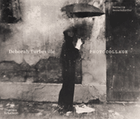
Deborah Turbeville (1932-2013) made her living--and her name--as a fashion photographer. Yet is there a photographer whose style seems less suited to the glossies? The monograph Deborah Turbeville: Photocollage by Nathalie Herschdorfer fulsomely celebrates this seeming contradiction and seeks to place Turbeville not only among her better-known fellow fashion photogs (Helmut Newton, Irving Penn) but among the finest photographers of her generation.
Herschdorfer (Body) bundles Turbeville's work into five sections separated by essays from various contributors. Throughout the book, T-pins, staples, and tape are fixtures of Turbeville's work. Many photos are in soft focus (some would say blurry). Several have deliberate-looking scratches. People's heads may be cropped. Settings tend to be disused properties and outposts. All of this, plus the fact that Turbeville worked largely in black and white and sepia tones, makes her photographs, as Herschdorfer points out, fairly impervious to dating. They're also eerily and ethereally beautiful.
The monograph includes images from Turbeville's notorious first series for American Vogue, from 1975, for which she photographed her models at a deserted Manhattan bathhouse. (Vogue got angry letters.) Also featured are images from a series commissioned by a fan of Turbeville's: Jacqueline Onassis. Then working in publishing, Onassis arranged for Turbeville's access to Versailles, and her collected photos of the palace's withered grandeur appeared in her 1981 book, Unseen Versailles. If that book failed to establish Turbeville as more than a fashion photographer--the artist's dream in her lifetime--then Deborah Turbeville may do the job posthumously. --Nell Beram, author and freelance writer

